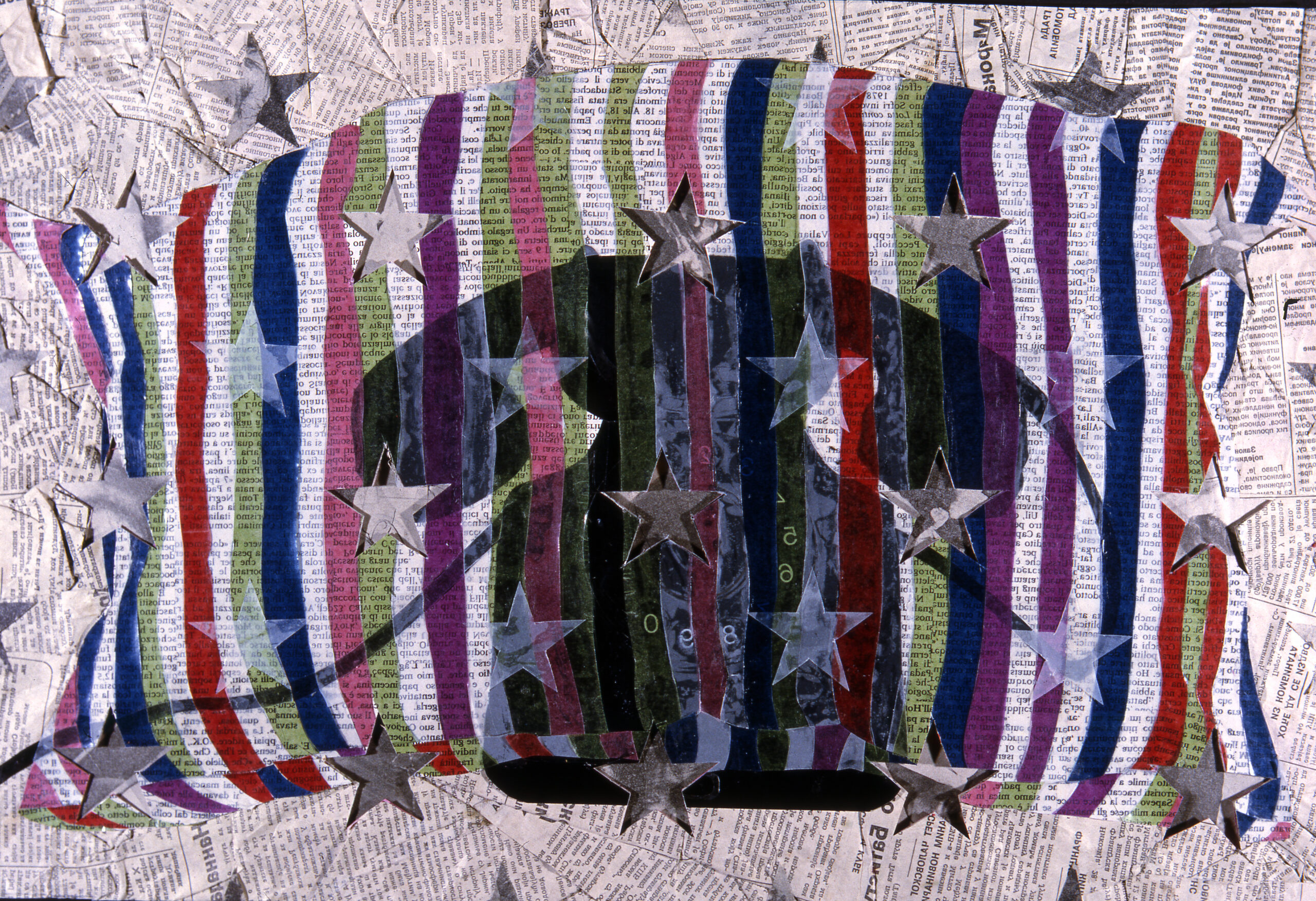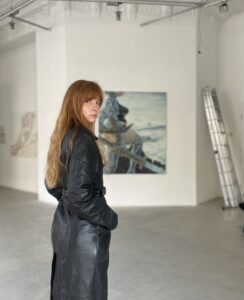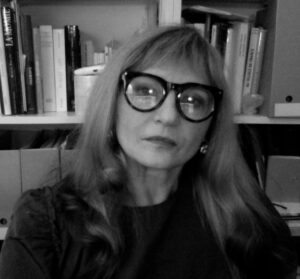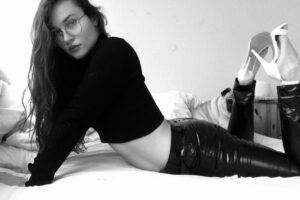Jelena Trpković
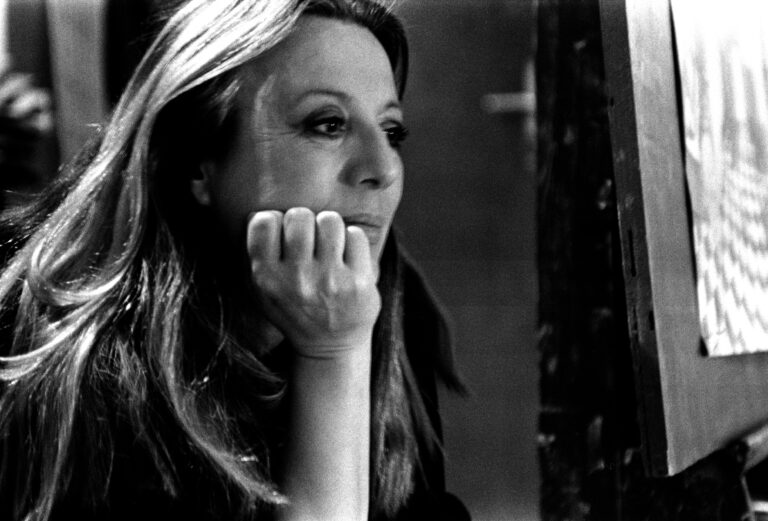
– born in Belgrade in 1952. She graduated from the Faculty of Fine Arts in Belgrade and completed postgraduate studies in the class of prof. Stojan Ćelić in 1976, and held her first exhibition at the Graphic Collective Gallery in 1977, when she became a member of ULUS (The Association of Fine Artists of Serbia). From 1980 to 1999, she lived as a freelance artist in Dubrovnik. She exhibited at over 100 collective exhibitions in the country and abroad and her works are kept in numerous museum and private collections. She is the recipient of numerous awards, among them: the Award of the Museum of Applied Art at the 41st October Salon (2009) and the award of the Ivan Tabaković Fund of SANU – The Serbian Academy of Sciences and Arts (2000). From 2000 to 2019, she worked as a full professor at the Academy of Arts in Novi Sad, at the Department of Drawing.
I was born in Belgrade in 1952 to parents whose families were painfully impoverished and devastated in World War II. My childhood was spent being exposed to the shocking stories and testimonies of war, as well as the feeling of not being adapted to the environment in which I grew up. Politics had a daily impact on all segments of life.
I drew and painted a lot, collected photos and various packaging papers, cut them, changed their purpose and context, not knowing that this was an introduction to the world of my art. The study years erased the line between private life and profession – art became my profession and at the same time my identity. To this day, the drawing remains the basis of my collages and montages. It is there in the process of cutting with scissors a certain artefact, selected after a long browsing through magazines and catalogs of all kinds, then in the base on which I place those artefacts as well as in the finishing of the work.
At the end of the 1980s, just before the beginning of the war in Yugoslavia, my works began to lose their color imperceptibly (Tanks, In the Cave, On the Shore, How do the Villages Burn?…)12, and the last work I did in that period I titled The Widow3, not knowing that I would soon become one. When the siege of Dubrovnik began, in which I was left alone, and when I felt powerless and the stormy weather for art approaching, I forced myself to make a series of paintings. I used the cloth from old bed sheets, discarded boards and packaging cardboard4. Also, during the war, in 1994, in Hotel Putnik – through which transit passengers, refugees and spies passed – in room no. 611, I made an exhibition of portraits of Macedonian artists drawn from behind. That’s how they became part of all of us who were the shooting targets.
The first works in which the influence of American pop art can be felt were created as a parody of easy-going bourgeois life and represent a sarcastic view of the male-female relationships. (Bim and Boom, Cha-Cha-Cha, American Monday, To Each Their Own, Annunciation, Aurora, Why Are Women Afraid of the Cars…)567. In those works, I also dealt with the issue of sexuality (a series of works Mom’s Big Sweater, Daffodil, Voyeur, In the Bathtub, Hot Water)8, putting in the foreground the male nude depicted in everyday situations (Gallery of the Cultural Centre “Dom Omladine Belgrade”, 1985 and Salon of the Museum of Contemporary Art Belgrade, 1992).
During those years I was politically engaged. At the end of the 1980s, while I was living in Dubrovnik, I joined Panella’s Transnational Radical Party, and later UJDI (Association for the Yugoslav Democratic Initiative). Both parties were short-lived. The war ended them and made them meaningless. In Belgrade, I joined the Social Democratic Union, whose members were from all over the former Yugoslavia. We had no influence on the changes in Slobodan Milošević’s disastrous policy, but we exchanged experiences and views. I was also involved in the work of the Belgrade Circle, and the Civil Resistance Movement, of which I am one of the founders and which was formed and named in the attic where I still live today. The actions we organized, such as The Black Ribbon and The Last Bell, today remain as symbols of resistance during the war years.
Also, literature has a lot of influence on my work. My attitude towards literature as well as my principled approach to work is shown in the exhibition Telephones for Nadezhda Mandelstam9 realised in 1995. In Nadezhda Mandelstam’s book Fear and Hope, there is a sentence that describes how every phone ringing brought bad news and how the heroes covered them with pillows to drown out the sound of ringing. I tried, without illustrating that sentence and steering away from the story, to create the atmosphere of the sentence and the time in which it was created with pure artistic elements, various textures and transparencies of the paper.
My approach to art was not an experiment, nor was I looking for triggers or waiting for inspiration. Inspiration does not exist in my work, there is only continuity; one work, one phase of work that starts the next one; I just enter from one state to another – everything is connected.
The text is written in collaboration with Simona Ognjanović (2022).
1Image: Jelena Trpković, Tanks, collage, 1989, courtesy of the artist.2Image: Jelena Trpković, In the Cave, collage, 1989, courtesy of the artist.
3Image: Jelena Trpković, The Widow, collage, 1991, courtesy of the artist.
4Image: Jelena Trpković, Atelier before the war, 1991, Dubrovnik, courtesy of the artist.
5Image: Jelena Trpković, American Monday, collage, 1988, courtesy of the artist.
6Image: Jelena Trpković, Why Are Women Afraid of the Cars, collage, 1991, courtesy of the artist.
7Image: Jelena Trpković, Aurora, collage, 2000, courtesy of the artist.
8Image: Jelena Trpković, Mom’s Big Sweater, collage, 1988, courtesy of the artist.
9Image: Jelena Trpković, Telephones for Nadezhda Mandelstam, collage, 1986, courtesy of the artist.
– je rođena u Beogradu 1952. godine. Fakultet likovnih umetnosti u Beogradu i poslediplomske studije završila u klasi prof. Stojana Ćelića 1976, a prvu izložbu priredila u Galeriji Grafički kolektiv 1977. godine kada postaje i član ULUS-a. Od 1980. do 1999. živela kao slobodna umetnica u Dubrovniku. Izlagala na preko 100 kolektivnih izložbi u zemlji i inostranstvu, a njeni radovi nalaze se u brojnim muzejskim i privatnim kolekcijama. Dobitnica je brojnih priznanja, među kojima se ističe Nagrada Muzeja primenjene umetnosti na 41. oktobarskom salonu (2009) i nagrada Fonda Ivana Tabakovića SANU (2000). Od 2000. do 2019. radila kao redovni profesor na Akademiji umetnosti u Novom Sadu, na Katedri za crtež.
Rođena sam u Beogradu 1952. godine od roditelja čije su porodice bolno osiromašile i devastirane u II svetskom ratu. Detinjstvo mi je proteklo u potresnim pričama i svedočenjima rata, kao i osećaju neprilagođenosti sredini u kojoj sam rasla. Politika je imala svakodnevni upliv u sve segmente života.
Crtala sam i slikala mnogo, prikupljala fotografije i razne papire od ambalaže, rezala ih, menjala im namenu i kontekst, ne znajući da je to uvod u svet moje umetnosti. Godine studiranja brisale su granicu između privatnog života i profesije, umetnost je postala moja profesija i ujedno moj identitet. Crtež je ostao do danas osnova mojih kolaža i montaža koje radim. On stoji u procesu rezanja makazama određenog artefakta odabranog dugotrajnim prelistavanjem časopisa i kataloga svih vrsta, zatim u podlozi na koje postavljam te artefakte kao i u doradi gotovog rada.
Krajem osamdesetih godina, neposredno pred početak rata u Jugoslaviji, moji radovi su neprimetno počeli da gube boju (Tenkovi, U pećini, Na obali, Kako sela gore?…)12, a poslednji rad koji sam u tom periodu izvela nazvala sam Udovica3, ne znajući da ću to uskoro postati. Kada je počela opsada Dubrovnika u kojoj sam ostala sama, i kada sam osećala nemoć i nevreme za umetnost, naterala sam sebe da napravim seriju slika. Koristila sam platno starih čaršafa, bačene daske i kartone od ambalaža4. Takođe, za vreme rata 1994, u Hotelu Putnik kroz koji su prolazile tranzitni putnici i izbeglice i špijuni, u sobi br. 611, napravila sam izložbu portreta makedonskih umetnika crtanih sa leđa. Tako su i oni postali deo svih nas koji smo bili mete za odstrel.
Prvi radovi u kojima se oseća uticaj američke pop umetnosti nastali su kao parodija na lagodan građanski život i predstavljaju sarkastičan pogled na muško-ženske odnose. (Bim I Bum, Ća-ća –ća, Američki ponedeljak, Svakom svoje, Blagovesti, Aurora, Zašto se žene boje auta…)567 U tim radovoma bavila sam se i pitanjem seksualnosti (serija radova Mamin veliki džemper, Narcis, Voajer, U kadi, Topla voda)8, stavljajući u prvi plan muški akt prikazan u svakodnevnim situacijama (Galerija Doma omladine Beograd 1985. I Salon Muzeja Savremene umetnosti, 1992.).
Tokom tih godina bila sam politički angažovana. Krajem osamdesetih, dok sam živela u Dubrovniku, učlanila sam se u Panelijevu stranku Za ujedinjenu Evropu, a kasnije u UJDI. Obe stranke bile su kratkog daha. Zaustavio ih je i obesmislio rat. U Beogradu sam se učlanila u Socijaldemokratsku uniju čiji su članovi bili iz cele bivše Jugoslavije. Uticaja na promene pogubne politike Slobodana Miloševića nismo imali, ali smo razmenjivali iskustva i stavove. Bila sam uključena i u rad Beogradskog kruga, a Civilni pokret otpora, čija sam jedna od osnivačica, formiran je i imenovan u potkrovlju u kojem i danas živim. Akcije koje smo organizovali poput Crnog flora i Poslednjeg zvona, ostale su i danas simboli otpora tokom ratnih godina.
Takođe, književnost ima mnogo uticaja na moj rad. Moj odnos prema književnosti, ali i načelan pristup radu, pokazuje izložba Telefoni za Nadeždu Mandeljštam9 realizovana 1995. godine. U knjizi Nadežde Mandeljštam Strah i nada nalazi se rečenica koja opisuje kako je svako zvono telefona donosilo lošu vest i kako su ih junaci prekrivali jastucima kako bi ugušili zvuk zvona. Pokušala sam, ne ilustrujući tu rečenicu i izbegavajući priču, da čistim likovnim elementima, raznim teksturama i transparentnostima papira, napravim atmosferu te rečenice i vreme u kojoj je ona nastala.
Moj pristup umetnosti nije bio eksperiment, niti sam tragala za pokretačima i čekala inspiraciju. Inspiracija ne postoji u mom radu, postoji samo kontinuitet, jedan rad, jedna faza rada koja pokreće narednu, iz jednog stanja samo ulazim u drugo, sve se nadovezuje.
Tekst je napisan u saradnji sa Simonom Ognjanović (2022).
1Ilustracija: Jelena Trpković, Tenkovi, kolaž, 1989, ljubaznošću umetnice.2Ilustracija: Jelena Trpković, U pećini, kolaž, 1989, ljubaznošću umetnice.
3Ilustracija: Jelena Trpković, Udovica, kolaž, 1991, ljubaznošću umetnice.
4Ilustracija: Jelena Trpković, Atelje pred rat u Dubrovniku, 1991, ljubaznošću umetnice.
5Ilustracija: Jelena Trpković, Američki ponedeljak, kolaž, 1988, ljubaznošću umetnice.
6Ilustracija: Jelena Trpković, Zašto se žene boje automobila, kolaž, 1991, ljubaznošću umetnice.
7Ilustracija: Jelena Trpković, Aurora, kolaž, 2000, ljubaznošću umetnice.
8Ilustracija: Jelena Trpković, Mamin veliki džemper, kolaž, 1988, ljubaznošću umetnice.
9Ilustracija: Jelena Trpković, Telefoni za Nadeždu Maneljštam, kolaž, 1986, ljubaznošću umetnice.
